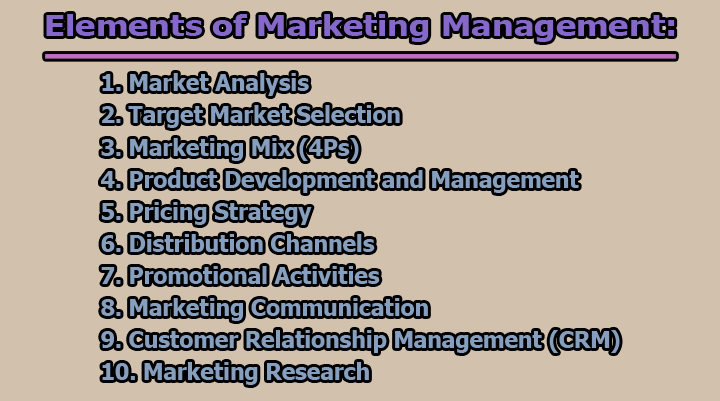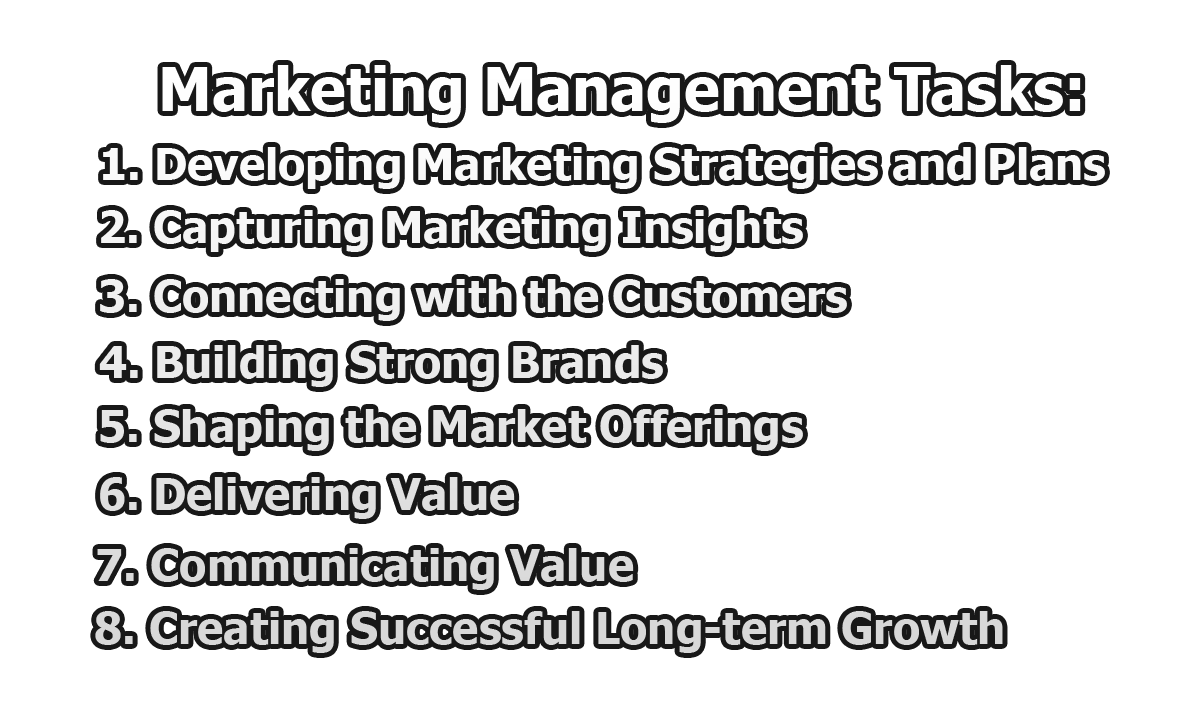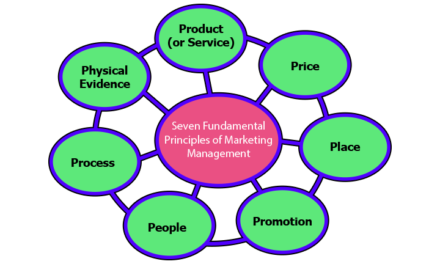Marketing management is a multifaceted discipline essential for organizations seeking success in today’s dynamic business environment. It involves a strategic approach to understanding markets, selecting target audiences, developing compelling products, and effectively communicating value propositions. In this article, we are going to know about marketing management and elements of marketing management.
Definitions of Marketing Management:
According to Philip Kotler, a renowned marketing scholar, marketing management is the “analysis, planning, implementation, and control of programs designed to bring about desired exchanges with target markets for the purpose of achieving organizational objectives” (Kotler et al., 2020, p. 33). This definition emphasizes the comprehensive nature of marketing management, encompassing strategic planning and tactical execution to meet organizational goals through customer interactions.
From Peter Drucker’s perspective, marketing management involves “understanding the customer so well that the product or service fits him and sells itself” (Drucker, 1973, p. 64). Drucker highlights the centrality of customer orientation in marketing, suggesting that effective marketing management entails aligning products or services closely with customer needs to facilitate natural and successful sales.
Kotler and Armstrong describe marketing management as the “art and science of choosing target markets and getting, keeping, and growing customers through creating, delivering, and communicating superior customer value” (Kotler & Armstrong, 2018, p. 9). This definition emphasizes the dynamic and value-centric nature of marketing management, highlighting the continuous process of acquiring and retaining customers through superior value propositions.
Theodore Levitt views marketing management as the “creation and delivery of a standard of living” (Levitt, 1960, p. 55). Levitt’s definition underscores the broader societal impact of marketing, suggesting that effective marketing management goes beyond mere transactions to contribute to the overall improvement of people’s lives by providing valuable solutions.
David Aaker focuses on the strategic aspect of marketing management, defining it as the “planning and execution of conception, pricing, promotion, and distribution of ideas, goods, and services to create exchanges that satisfy individual and organizational goals” (Aaker, 2012, p. 6). This definition emphasizes the role of marketing management in strategic decision-making across various elements to achieve both individual and organizational objectives.
Elements of Marketing Management:
Marketing management involves several interconnected elements that collectively contribute to the success of an organization’s marketing efforts. Here are some of the key elements of marketing management:
1. Market Analysis: Market analysis involves a comprehensive examination of the external environment, including market trends, customer behavior, and competitive dynamics (Kotler & Keller, 2016, p. 86). This process helps organizations understand the current state of the market and anticipate future developments. Techniques such as SWOT analysis (Strengths, Weaknesses, Opportunities, Threats) assist in identifying internal capabilities and vulnerabilities, as well as external opportunities and threats, guiding strategic decision-making.
2. Target Market Selection: Target market selection is the process of identifying specific segments of the population that an organization aims to reach with its products or services (Pride & Ferrell, 2019, p. 154). This involves analyzing demographic, psychographic, and behavioral factors to determine which customer segments align best with the organization’s offerings. By focusing resources on these target markets, companies can tailor their marketing efforts more effectively and enhance overall efficiency.
3. Marketing Mix (4Ps): The marketing mix, often referred to as the 4Ps, encompasses product, price, place, and promotion strategies (Kotler et al., 2020, p. 17). Product decisions involve designing and developing offerings that meet customer needs. Pricing strategy involves determining the appropriate price for the product, considering factors such as cost, competition, and perceived value. Place involves selecting distribution channels to make the product accessible to customers, and promotion includes activities like advertising and personal selling to communicate the product’s value.
4. Product Development and Management: Product development and management focus on creating and maintaining products or services that meet or exceed customer expectations (Boone & Kurtz, 2016, p. 226). This involves continuous innovation, quality control, and understanding the product life cycle. Organizations must adapt their products to changing market demands and technological advancements to remain competitive.
5. Pricing Strategy: Pricing strategy is the process of determining the optimal price for a product or service based on various factors, including production costs, market demand, and competitor pricing (Anderson et al., 2021, p. 98). Pricing decisions directly impact a company’s revenue and profitability. Organizations may adopt strategies such as cost-plus pricing, value-based pricing, or competitive pricing, depending on their market positioning and objectives.
6. Distribution Channels: Distribution channels involve the pathways through which products or services reach customers. Effective channel management ensures that products are delivered efficiently and are readily available to the target audience (Czinkota et al., 2019, p. 324). Decisions related to distribution channels include choices between direct distribution (selling directly to customers) and indirect distribution (using intermediaries like retailers or wholesalers) and optimizing the supply chain for timely and cost-effective delivery.
7. Promotional Activities: Promotional activities encompass various methods used to communicate the value of a product or service to the target market. This includes advertising, personal selling, public relations, and sales promotion (Belch & Belch, 2020, p. 9). Organizations develop integrated promotional strategies to create awareness, generate interest, and stimulate demand for their offerings.
8. Marketing Communication: Marketing communication involves the creation and delivery of consistent and persuasive messages to target audiences. It includes both traditional and digital communication methods, such as advertising, public relations, social media, and content marketing (Fill, 2019, p. 76). Effective marketing communication aims to build brand awareness, shape perceptions, and influence consumer behavior.
9. Customer Relationship Management (CRM): CRM focuses on building and maintaining long-term relationships with customers. It involves understanding customer needs, preferences, and behaviors to enhance customer satisfaction and loyalty (Peppers & Rogers, 2016, p. 32). CRM strategies often incorporate technology to manage customer interactions and data, facilitating personalized marketing and improving the overall customer experience.
10. Marketing Research: Marketing research is the systematic gathering, analysis, and interpretation of information related to market trends, consumer behavior, and competitive activities (Malhotra, 2019, p. 15). This element provides valuable insights that guide decision-making processes, helping organizations stay responsive to market changes, identify new opportunities, and refine their marketing strategies.
In conclusion, effective marketing management is indispensable for organizations striving to thrive in competitive markets. The elements discussed, ranging from market analysis and target market selection to distribution channels, promotional activities, and customer relationship management, collectively form a strategic framework that guides organizations toward achieving their objectives. By understanding and mastering these elements, companies can navigate the complexities of the market, build strong connections with customers, and adapt to ever-evolving business landscapes. In an era where customer-centricity and adaptability are paramount, a robust marketing management approach remains a cornerstone for organizational growth and sustainability.
References:
- Aaker, D. A. (2012). Building Strong Brands. Simon and Schuster.
- Anderson, D., Sweeney, D., & Williams, T. (2021). Statistics for Business & Economics. Cengage Learning.
- Belch, G. E., & Belch, M. A. (2020). Advertising and promotion: An integrated marketing communications perspective. McGraw-Hill Education.
- Boone, L. E., & Kurtz, D. L. (2016). Contemporary marketing. Cengage Learning.
- Czinkota, M. R., Ronkainen, I. A., & Moffett, M. H. (2019). International Business. Wiley.
- Drucker, P. F. (1973). Management: Tasks, Responsibilities, Practices. Harper & Row.
- Fill, C. (2019). Marketing Communications: Brands, Experiences and Participation. Pearson.
- Kotler, P., & Armstrong, G. (2018). Principles of Marketing. Pearson.
- Kotler, P., Armstrong, G., & Cunningham, P. H. (2020). Principles of marketing. Pearson.
- Kotler, P., & Keller, K. L. (2016). Marketing Management. Pearson.
- Levitt, T. (1960). Marketing myopia. Harvard Business Review, 38(4), 45-56.
- Malhotra, N. K. (2019). Marketing research: An applied orientation. Pearson.
- Peppers, D., & Rogers, M. (2016). Managing Customer Experience and Relationships: A Strategic Framework. John Wiley & Sons.
- Pride, W. M., & Ferrell, O. C. (2019). Marketing: Concepts and strategies. Cengage Learning.

Library Lecturer at Nurul Amin Degree College










